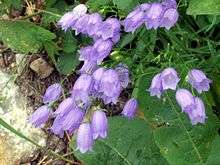Campanulaceae
| Campanulaceae | |
|---|---|
 | |
| Campanula cespitosa | |
| Scientific classification | |
| Kingdom: | Plantae |
| (unranked): | Angiosperms |
| (unranked): | Eudicots |
| (unranked): | Asterids |
| Order: | Asterales |
| Family: | Campanulaceae Juss.[1] |
| Genera | |
|
See text. | |
The family Campanulaceae (also bellflower family), of the order Asterales, contains nearly 2400 species in 84 genera of herbaceous plants, shrubs, and rarely small trees, often with milky non-toxic sap.[2] Among them are the familiar garden plants Campanula (bellflower), Lobelia, and Platycodon (balloonflower).
This family is almost cosmopolitan but concentrated in the Northern Hemisphere. However in the Southern Hemisphere, South Africa is remarkably rich in members of this family. These species are absent in the Sahara, Antarctica, and northern Greenland.
Most current classifications include the segregate family Lobeliaceae in Campanulaceae as subfamily Lobelioideae.
Description
Leaves are often alternate, more rarely opposite. They are also simple and without stipules.
Flowers are bisexual, bell-shaped, consisting of a narrow tube-like corolla with small spreading lobes. Many are blue.
Fruits are berries or capsules.
Subfamilies and genera
- Campanuloideae
- Adenophora
- Astrocodon
- Asyneuma
- Azorina
- Berenice
- Campanula – Bellflower
- Canarina
- Codonopsis
- Craterocapsa
- Cryptocodon
- Cyananthus
- Cylindrocarpa
- Echinocodon
- Edraianthus
- Feeria
- Gadellia
- Githopsis – Bluecup
- Gunillaea
- Hanabusaya
- Heterochaenia
- Heterocodon
- Homocodon
- Jasione
- Legousia – Venus' Looking-glass
- Leptocodon
- Lightfootia
- Merciera
- Michauxia
- Microcodon
- Musschia
- Namacodon
- Nesocodon
- Numaeacampa
- Ostrowskia
- Peracarpa
- Petromarula
- Physoplexis
- Phyteuma
- Platycodon – Balloonflower
- Popoviocodonia
- Prismatocarpus
- Rhigiophyllum
- Roella
- Sergia
- Siphocodon
- Symphyandra
- Theilera
- Trachelium
- Treichelia
- Triodanis
- Wahlenbergia
- Zeugandra
- Apetahia
- Brighamia
- Burmeistera
- Centropogon
- Clermontia
- Cyanea
- Delissea
- Dialypetalum
- Diastatea
- Dielsantha
- Downingia – Calicoflower
- Grammatotheca
- Heterotoma
- Hippobroma
- Howellia
- Hypsela
- Isotoma
- Laurentia = Isotoma, Solenopsis, Hippobroma
- Legenere – False Venus' Looking-glass
- Lobelia
- Lysipomia
- Monopsis
- Palmerella
- Porterella
- Pratia
- Ruthiella
- Sclerotheca
- Siphocampylus
- Solenopsis
- Trematocarpus
- Trematolobelia – False Lobelia
- Trimeris
- Unigenes
- Cyphioideae
Fossil record
The earliest known occurrence of Campanulaceae pollen is from Oligocene strata.[3]Earliest Campanulaceae macrofossils dated, are seeds of †Campanula paleopyramidalis from 17-16 million years old Miocene deposits in the Nowy Sacz, Carpathians, Poland. It is a close relative of the extant Campanula pyramidalis.[4][5]
Literature
- Lammers, T.G. (2007) World Checklist and Bibliography of Campanulaceae. Kew Publishing, Richmond, Surrey.
- Fedorov, A., & Kovanda, M. (1976) Campanulaceae. In Flora Europaea (T.G. Tutin, V.H. Heywood, N.A. Burges, D.M. Moore, D.H. Valentine, S.M. Walters, & D.A. Webb, Eds.), Cambridge: Cambridge University Press, pp 74–93.
- Borsch, T.; Korotkova, N.; Raus, T.; Lobin, W.; Loehne, C. (2009). "The petD group II intron as a genus and species level marker: Utility for tree inference and species identification in the diverse genus Campanula (Campanulaceae)". Willdenowia. 39: 7–33. doi:10.3372/wi.39.39101.
- Roquet, C.; Sáez, L.; Aldasoro, J. J.; Alfonso, S.; Alarcón, M. L.; Garcia-Jacas, N. (2008). "Natural delineation, molecular phylogeny and floral evolution in Campanula". Systematic Botany. 33: 203–217. doi:10.1600/036364408783887465.
- Cosner, M. E.; Raubeson, L. A.; Jansen, R. K. (2007). "Chloroplast DNA rearrangements in Campanulaceae: phylogenetic utility of highly rearranged genomes" (PDF). BMC Evolutionary Biology. 4 (27): 1–17. doi:10.1186/1471-2148-4-27.
- Eddie, W. M. M.; Shulkina, T.; Gaskin, J.; Haberle, R. C.; Jansen, R. K. (2003). "Phylogeny of Campanulaceae s. str. inferred from ITS sequences of nuclear ribosomal DNA". Annals of the Missouri Botanical Garden. 90 (4): 554–575. doi:10.2307/3298542.
References
- ↑ Angiosperm Phylogeny Group (2009), "An update of the Angiosperm Phylogeny Group classification for the orders and families of flowering plants: APG III", Botanical Journal of the Linnean Society, 161 (2): 105–121, doi:10.1111/j.1095-8339.2009.00996.x, retrieved 2010-12-10
- ↑ Lammers, Thomas. "Revision of the Infrageneric Classification of Lobelia L. (Campanulaceae: Lobelioideae)". Annals of the Missouri Botanical Garden. 98: 37–62. doi:10.3417/2007150.
- ↑ Early Flowers and Angiosperm Evolution by Else Marie Friis, Swedish Museum of Natural History, Peter R. Crane, Yale University, Connecticut and Kaj Raunsgaard Pedersen, Aarhus Universitet, Published: August 2011, hardback. ISBN 9780521592833
- ↑ http://www.amjbot.org/content/early/2016/02/09/ajb.1500450.full.pdf
- ↑ https://www.ncbi.nlm.nih.gov/pmc/articles/PMC4950005/
External links
- Topwalks
- L. Watson and M.J. Dallwitz (1992 onwards). The families of flowering plants: descriptions, illustrations, identification, information retrieval.
- Germplasm Resources Information Network
- Flowers in Israel
- Angiosperm Phylogeny Website